Strategic Analysis of NHS People Management Challenges and Solutions
VerifiedAdded on 2023/04/22
|12
|2710
|189
Report
AI Summary
This report examines the people management challenges faced by the UK's National Health Service (NHS), focusing on issues like employee shortages, improper organizational culture, and high turnover rates. The analysis identifies key strategic initiatives, including leadership and management practices, training and development programs, and talent management strategies. The report delves into the impact of traditional leadership styles and suggests adopting transformational leadership to foster a collaborative environment and improve employee engagement. It also explores the application of Herzberg’s Two-Factor Theory to address motivation and job satisfaction, as well as a personality development framework to create a more effective talent management approach. The study recommends a focus on transformational leadership, Herzberg’s theory, and talent management strategies based on individual capabilities to improve service standards and achieve future goals within the NHS.

Running head: MANAGEMENT
Management
Name of the student
Name of the university
Author note
Management
Name of the student
Name of the university
Author note
Paraphrase This Document
Need a fresh take? Get an instant paraphrase of this document with our AI Paraphraser
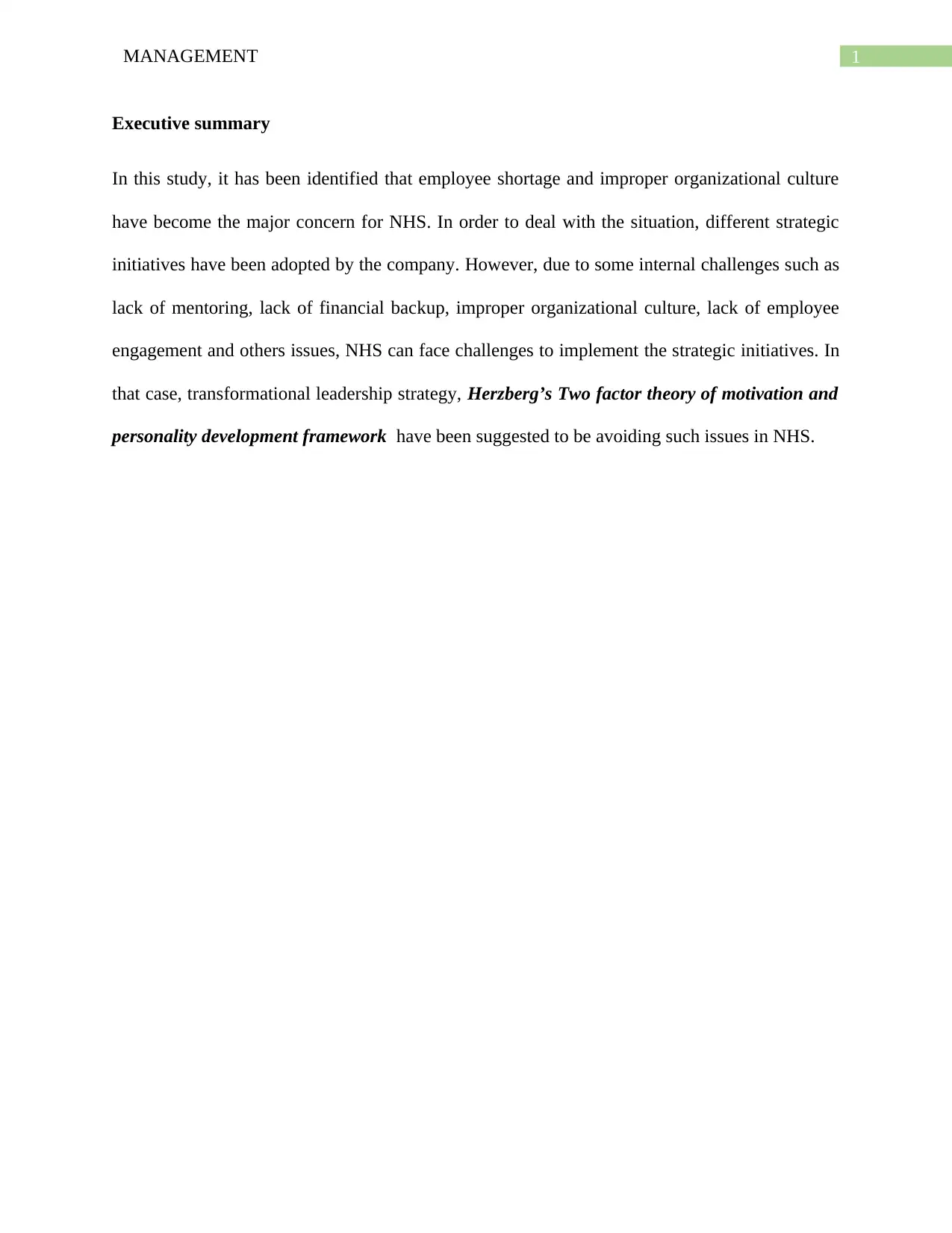
1MANAGEMENT
Executive summary
In this study, it has been identified that employee shortage and improper organizational culture
have become the major concern for NHS. In order to deal with the situation, different strategic
initiatives have been adopted by the company. However, due to some internal challenges such as
lack of mentoring, lack of financial backup, improper organizational culture, lack of employee
engagement and others issues, NHS can face challenges to implement the strategic initiatives. In
that case, transformational leadership strategy, Herzberg’s Two factor theory of motivation and
personality development framework have been suggested to be avoiding such issues in NHS.
Executive summary
In this study, it has been identified that employee shortage and improper organizational culture
have become the major concern for NHS. In order to deal with the situation, different strategic
initiatives have been adopted by the company. However, due to some internal challenges such as
lack of mentoring, lack of financial backup, improper organizational culture, lack of employee
engagement and others issues, NHS can face challenges to implement the strategic initiatives. In
that case, transformational leadership strategy, Herzberg’s Two factor theory of motivation and
personality development framework have been suggested to be avoiding such issues in NHS.
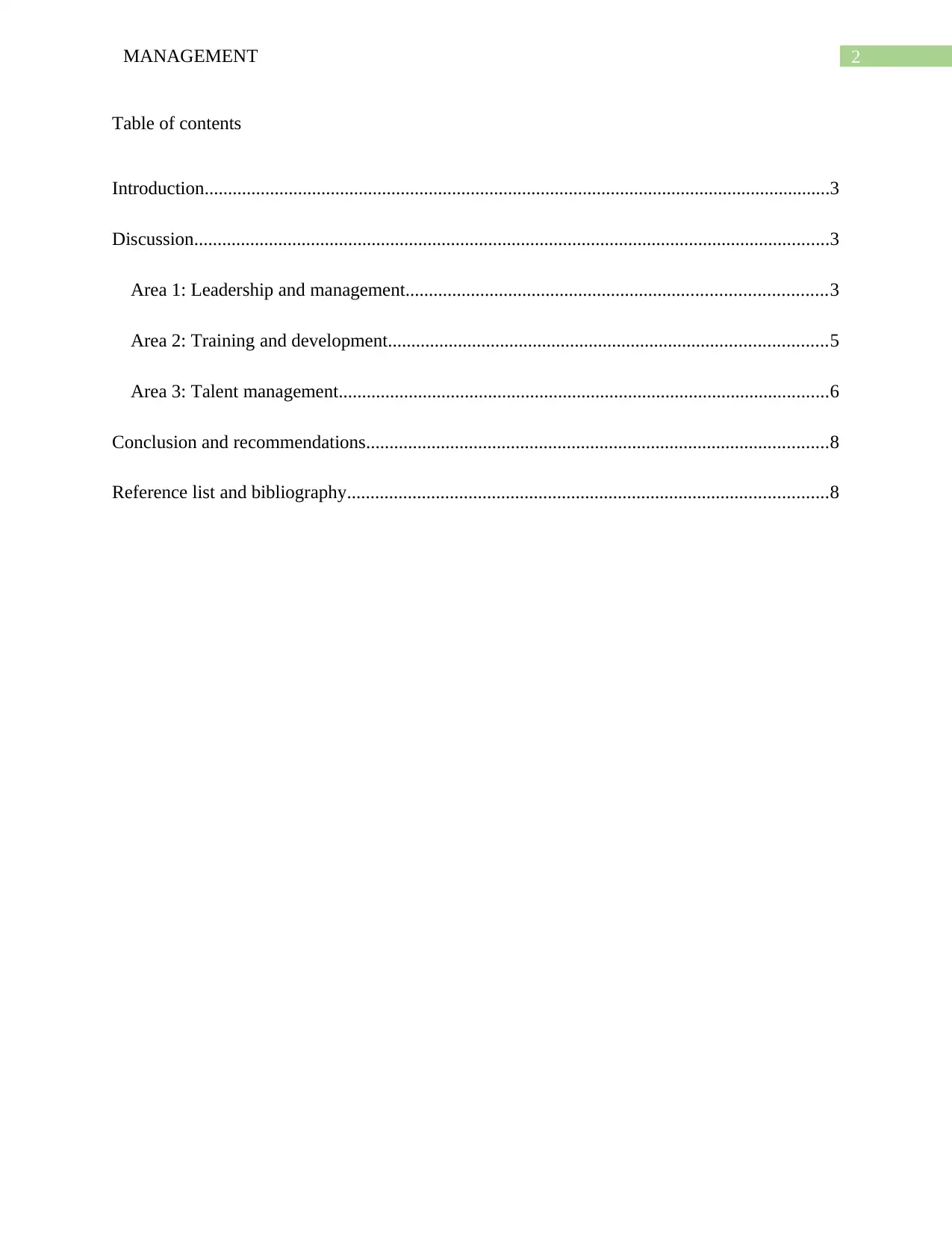
2MANAGEMENT
Table of contents
Introduction......................................................................................................................................3
Discussion........................................................................................................................................3
Area 1: Leadership and management..........................................................................................3
Area 2: Training and development..............................................................................................5
Area 3: Talent management.........................................................................................................6
Conclusion and recommendations...................................................................................................8
Reference list and bibliography.......................................................................................................8
Table of contents
Introduction......................................................................................................................................3
Discussion........................................................................................................................................3
Area 1: Leadership and management..........................................................................................3
Area 2: Training and development..............................................................................................5
Area 3: Talent management.........................................................................................................6
Conclusion and recommendations...................................................................................................8
Reference list and bibliography.......................................................................................................8
⊘ This is a preview!⊘
Do you want full access?
Subscribe today to unlock all pages.

Trusted by 1+ million students worldwide
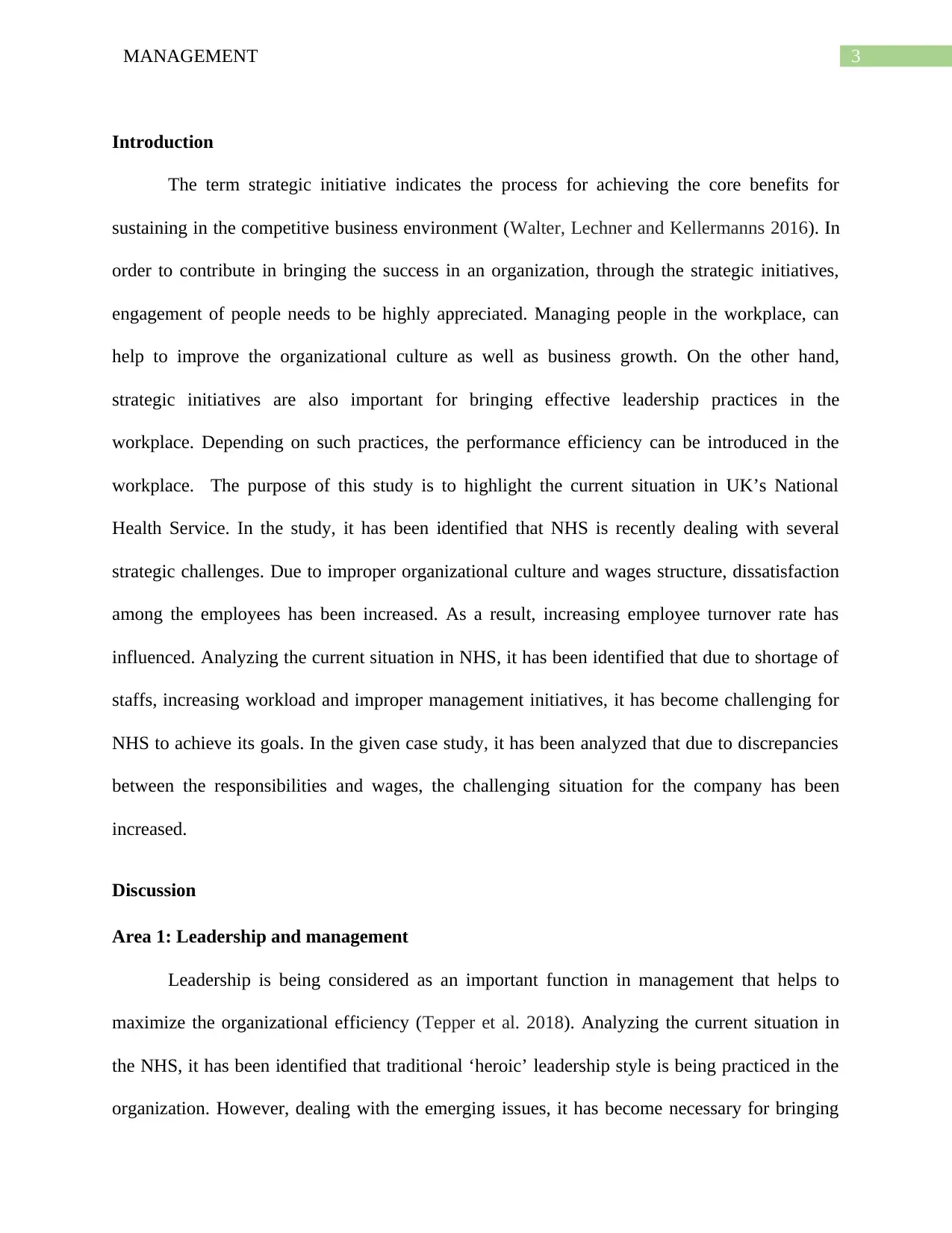
3MANAGEMENT
Introduction
The term strategic initiative indicates the process for achieving the core benefits for
sustaining in the competitive business environment (Walter, Lechner and Kellermanns 2016). In
order to contribute in bringing the success in an organization, through the strategic initiatives,
engagement of people needs to be highly appreciated. Managing people in the workplace, can
help to improve the organizational culture as well as business growth. On the other hand,
strategic initiatives are also important for bringing effective leadership practices in the
workplace. Depending on such practices, the performance efficiency can be introduced in the
workplace. The purpose of this study is to highlight the current situation in UK’s National
Health Service. In the study, it has been identified that NHS is recently dealing with several
strategic challenges. Due to improper organizational culture and wages structure, dissatisfaction
among the employees has been increased. As a result, increasing employee turnover rate has
influenced. Analyzing the current situation in NHS, it has been identified that due to shortage of
staffs, increasing workload and improper management initiatives, it has become challenging for
NHS to achieve its goals. In the given case study, it has been analyzed that due to discrepancies
between the responsibilities and wages, the challenging situation for the company has been
increased.
Discussion
Area 1: Leadership and management
Leadership is being considered as an important function in management that helps to
maximize the organizational efficiency (Tepper et al. 2018). Analyzing the current situation in
the NHS, it has been identified that traditional ‘heroic’ leadership style is being practiced in the
organization. However, dealing with the emerging issues, it has become necessary for bringing
Introduction
The term strategic initiative indicates the process for achieving the core benefits for
sustaining in the competitive business environment (Walter, Lechner and Kellermanns 2016). In
order to contribute in bringing the success in an organization, through the strategic initiatives,
engagement of people needs to be highly appreciated. Managing people in the workplace, can
help to improve the organizational culture as well as business growth. On the other hand,
strategic initiatives are also important for bringing effective leadership practices in the
workplace. Depending on such practices, the performance efficiency can be introduced in the
workplace. The purpose of this study is to highlight the current situation in UK’s National
Health Service. In the study, it has been identified that NHS is recently dealing with several
strategic challenges. Due to improper organizational culture and wages structure, dissatisfaction
among the employees has been increased. As a result, increasing employee turnover rate has
influenced. Analyzing the current situation in NHS, it has been identified that due to shortage of
staffs, increasing workload and improper management initiatives, it has become challenging for
NHS to achieve its goals. In the given case study, it has been analyzed that due to discrepancies
between the responsibilities and wages, the challenging situation for the company has been
increased.
Discussion
Area 1: Leadership and management
Leadership is being considered as an important function in management that helps to
maximize the organizational efficiency (Tepper et al. 2018). Analyzing the current situation in
the NHS, it has been identified that traditional ‘heroic’ leadership style is being practiced in the
organization. However, dealing with the emerging issues, it has become necessary for bringing
Paraphrase This Document
Need a fresh take? Get an instant paraphrase of this document with our AI Paraphraser
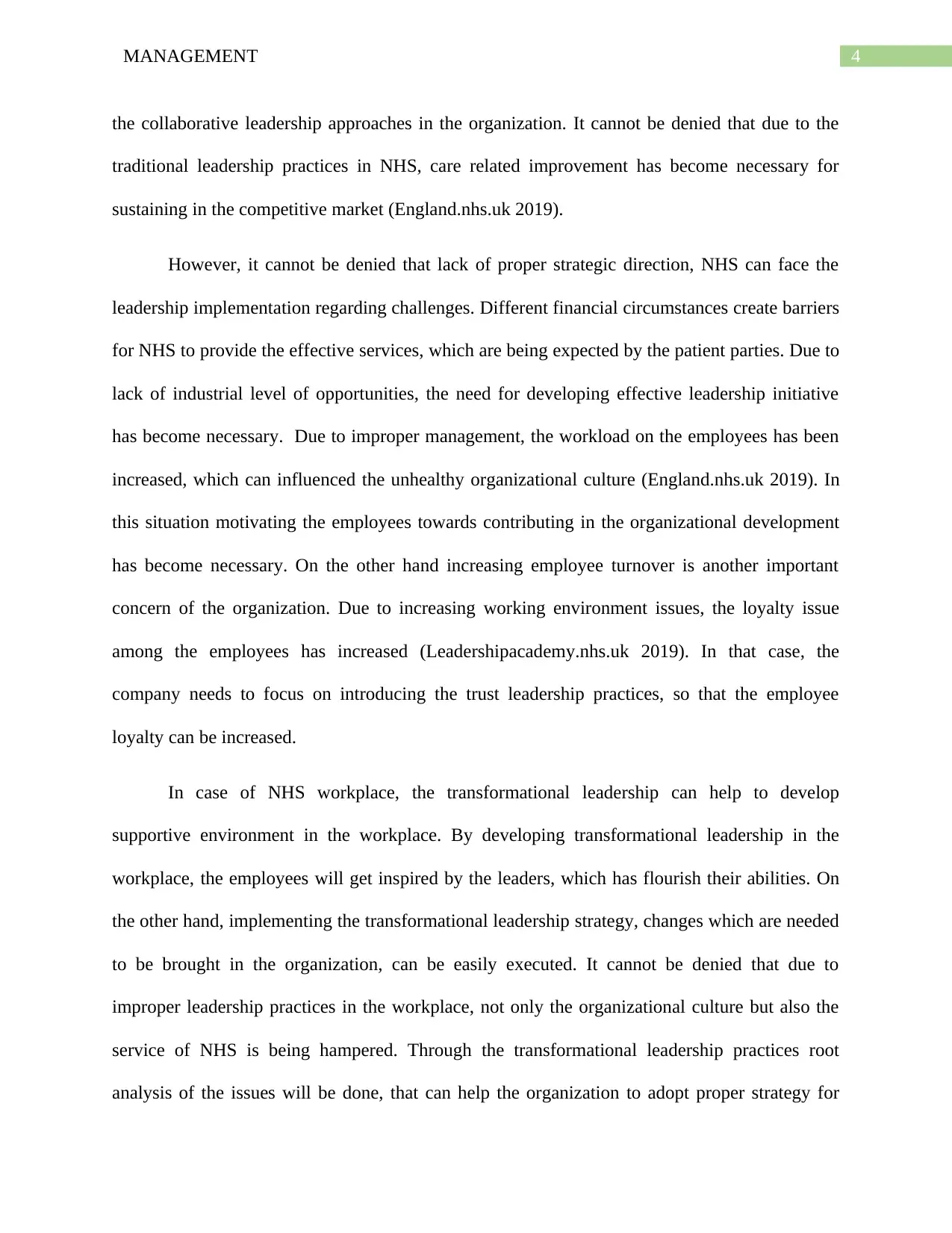
4MANAGEMENT
the collaborative leadership approaches in the organization. It cannot be denied that due to the
traditional leadership practices in NHS, care related improvement has become necessary for
sustaining in the competitive market (England.nhs.uk 2019).
However, it cannot be denied that lack of proper strategic direction, NHS can face the
leadership implementation regarding challenges. Different financial circumstances create barriers
for NHS to provide the effective services, which are being expected by the patient parties. Due to
lack of industrial level of opportunities, the need for developing effective leadership initiative
has become necessary. Due to improper management, the workload on the employees has been
increased, which can influenced the unhealthy organizational culture (England.nhs.uk 2019). In
this situation motivating the employees towards contributing in the organizational development
has become necessary. On the other hand increasing employee turnover is another important
concern of the organization. Due to increasing working environment issues, the loyalty issue
among the employees has increased (Leadershipacademy.nhs.uk 2019). In that case, the
company needs to focus on introducing the trust leadership practices, so that the employee
loyalty can be increased.
In case of NHS workplace, the transformational leadership can help to develop
supportive environment in the workplace. By developing transformational leadership in the
workplace, the employees will get inspired by the leaders, which has flourish their abilities. On
the other hand, implementing the transformational leadership strategy, changes which are needed
to be brought in the organization, can be easily executed. It cannot be denied that due to
improper leadership practices in the workplace, not only the organizational culture but also the
service of NHS is being hampered. Through the transformational leadership practices root
analysis of the issues will be done, that can help the organization to adopt proper strategy for
the collaborative leadership approaches in the organization. It cannot be denied that due to the
traditional leadership practices in NHS, care related improvement has become necessary for
sustaining in the competitive market (England.nhs.uk 2019).
However, it cannot be denied that lack of proper strategic direction, NHS can face the
leadership implementation regarding challenges. Different financial circumstances create barriers
for NHS to provide the effective services, which are being expected by the patient parties. Due to
lack of industrial level of opportunities, the need for developing effective leadership initiative
has become necessary. Due to improper management, the workload on the employees has been
increased, which can influenced the unhealthy organizational culture (England.nhs.uk 2019). In
this situation motivating the employees towards contributing in the organizational development
has become necessary. On the other hand increasing employee turnover is another important
concern of the organization. Due to increasing working environment issues, the loyalty issue
among the employees has increased (Leadershipacademy.nhs.uk 2019). In that case, the
company needs to focus on introducing the trust leadership practices, so that the employee
loyalty can be increased.
In case of NHS workplace, the transformational leadership can help to develop
supportive environment in the workplace. By developing transformational leadership in the
workplace, the employees will get inspired by the leaders, which has flourish their abilities. On
the other hand, implementing the transformational leadership strategy, changes which are needed
to be brought in the organization, can be easily executed. It cannot be denied that due to
improper leadership practices in the workplace, not only the organizational culture but also the
service of NHS is being hampered. Through the transformational leadership practices root
analysis of the issues will be done, that can help the organization to adopt proper strategy for
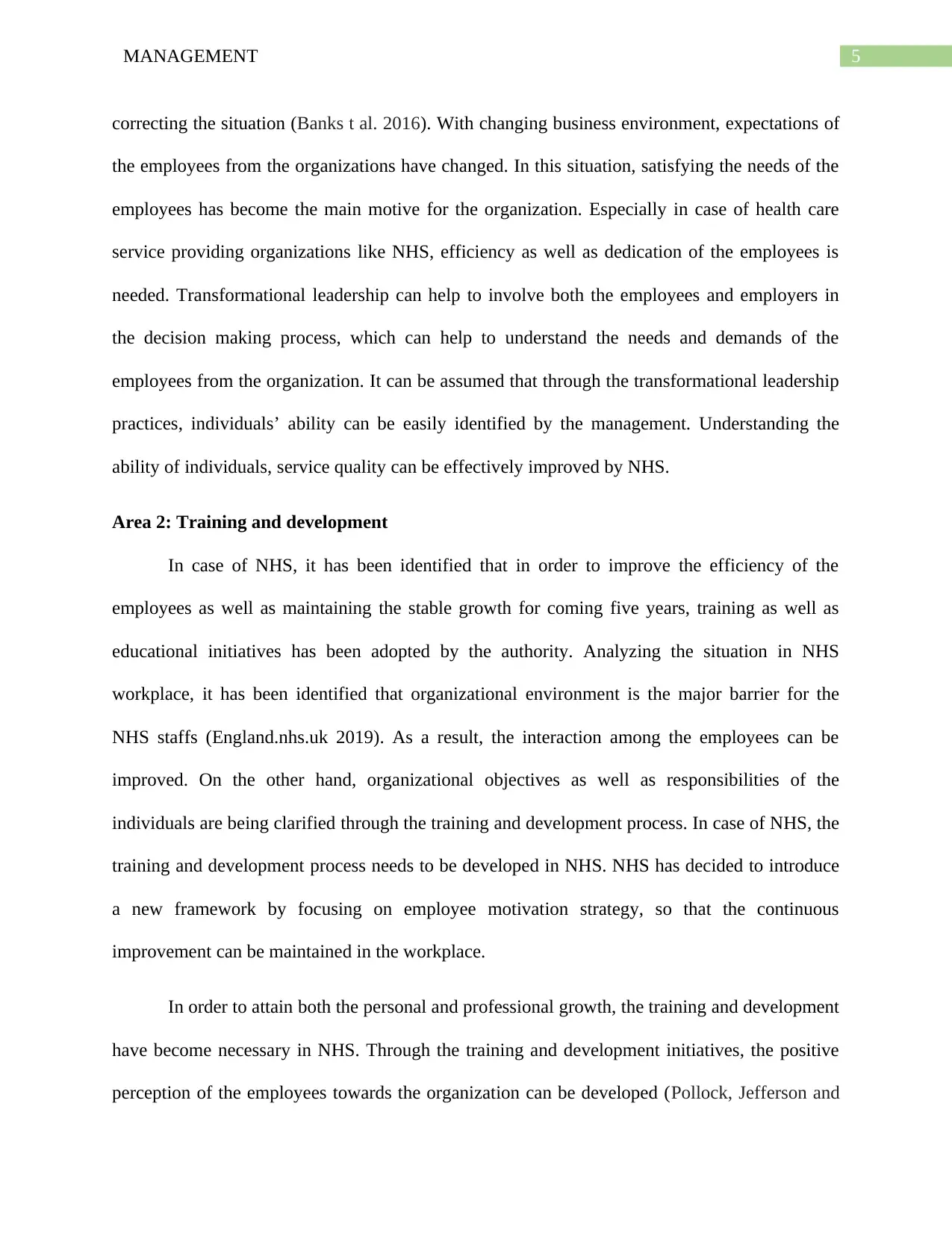
5MANAGEMENT
correcting the situation (Banks t al. 2016). With changing business environment, expectations of
the employees from the organizations have changed. In this situation, satisfying the needs of the
employees has become the main motive for the organization. Especially in case of health care
service providing organizations like NHS, efficiency as well as dedication of the employees is
needed. Transformational leadership can help to involve both the employees and employers in
the decision making process, which can help to understand the needs and demands of the
employees from the organization. It can be assumed that through the transformational leadership
practices, individuals’ ability can be easily identified by the management. Understanding the
ability of individuals, service quality can be effectively improved by NHS.
Area 2: Training and development
In case of NHS, it has been identified that in order to improve the efficiency of the
employees as well as maintaining the stable growth for coming five years, training as well as
educational initiatives has been adopted by the authority. Analyzing the situation in NHS
workplace, it has been identified that organizational environment is the major barrier for the
NHS staffs (England.nhs.uk 2019). As a result, the interaction among the employees can be
improved. On the other hand, organizational objectives as well as responsibilities of the
individuals are being clarified through the training and development process. In case of NHS, the
training and development process needs to be developed in NHS. NHS has decided to introduce
a new framework by focusing on employee motivation strategy, so that the continuous
improvement can be maintained in the workplace.
In order to attain both the personal and professional growth, the training and development
have become necessary in NHS. Through the training and development initiatives, the positive
perception of the employees towards the organization can be developed (Pollock, Jefferson and
correcting the situation (Banks t al. 2016). With changing business environment, expectations of
the employees from the organizations have changed. In this situation, satisfying the needs of the
employees has become the main motive for the organization. Especially in case of health care
service providing organizations like NHS, efficiency as well as dedication of the employees is
needed. Transformational leadership can help to involve both the employees and employers in
the decision making process, which can help to understand the needs and demands of the
employees from the organization. It can be assumed that through the transformational leadership
practices, individuals’ ability can be easily identified by the management. Understanding the
ability of individuals, service quality can be effectively improved by NHS.
Area 2: Training and development
In case of NHS, it has been identified that in order to improve the efficiency of the
employees as well as maintaining the stable growth for coming five years, training as well as
educational initiatives has been adopted by the authority. Analyzing the situation in NHS
workplace, it has been identified that organizational environment is the major barrier for the
NHS staffs (England.nhs.uk 2019). As a result, the interaction among the employees can be
improved. On the other hand, organizational objectives as well as responsibilities of the
individuals are being clarified through the training and development process. In case of NHS, the
training and development process needs to be developed in NHS. NHS has decided to introduce
a new framework by focusing on employee motivation strategy, so that the continuous
improvement can be maintained in the workplace.
In order to attain both the personal and professional growth, the training and development
have become necessary in NHS. Through the training and development initiatives, the positive
perception of the employees towards the organization can be developed (Pollock, Jefferson and
⊘ This is a preview!⊘
Do you want full access?
Subscribe today to unlock all pages.

Trusted by 1+ million students worldwide
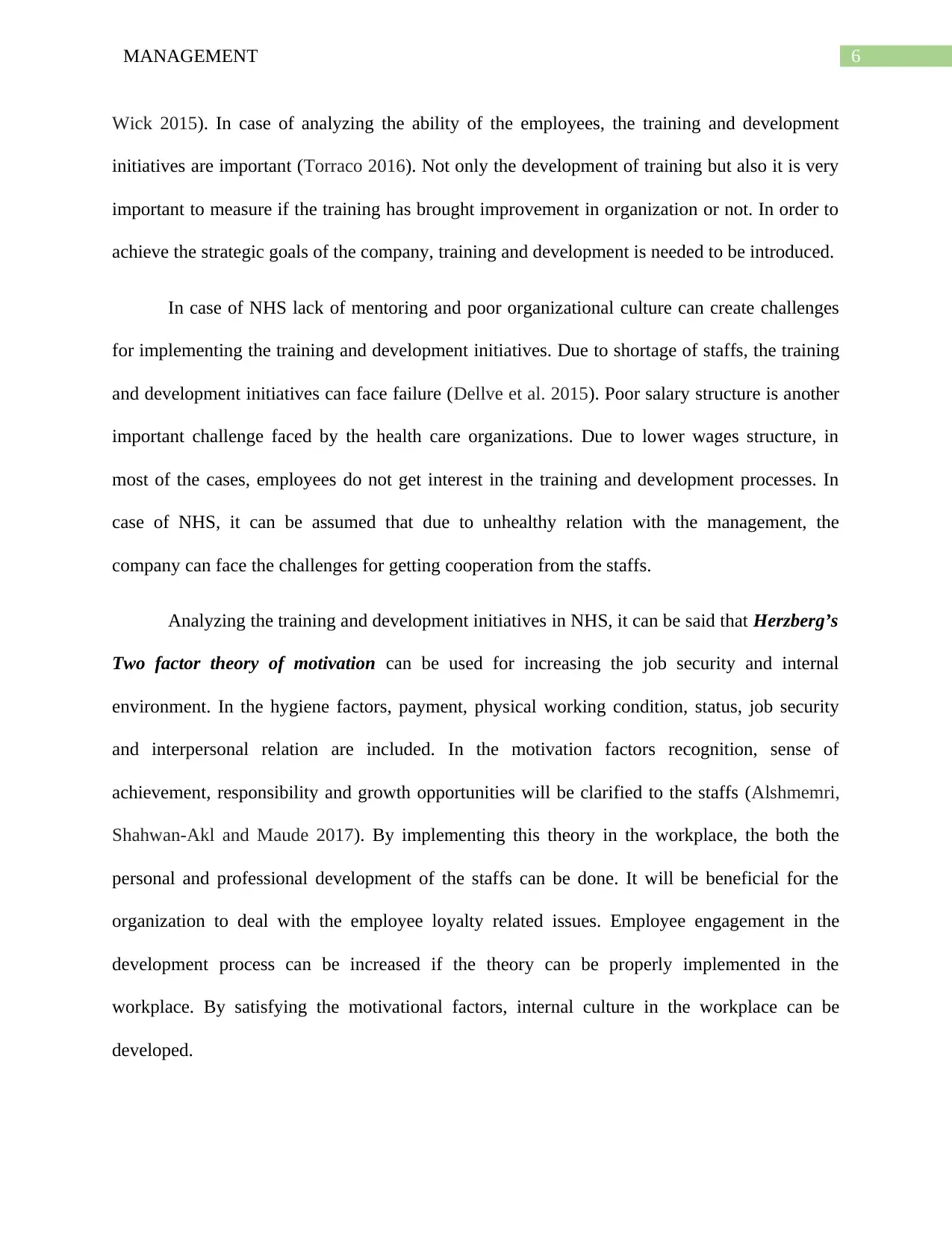
6MANAGEMENT
Wick 2015). In case of analyzing the ability of the employees, the training and development
initiatives are important (Torraco 2016). Not only the development of training but also it is very
important to measure if the training has brought improvement in organization or not. In order to
achieve the strategic goals of the company, training and development is needed to be introduced.
In case of NHS lack of mentoring and poor organizational culture can create challenges
for implementing the training and development initiatives. Due to shortage of staffs, the training
and development initiatives can face failure (Dellve et al. 2015). Poor salary structure is another
important challenge faced by the health care organizations. Due to lower wages structure, in
most of the cases, employees do not get interest in the training and development processes. In
case of NHS, it can be assumed that due to unhealthy relation with the management, the
company can face the challenges for getting cooperation from the staffs.
Analyzing the training and development initiatives in NHS, it can be said that Herzberg’s
Two factor theory of motivation can be used for increasing the job security and internal
environment. In the hygiene factors, payment, physical working condition, status, job security
and interpersonal relation are included. In the motivation factors recognition, sense of
achievement, responsibility and growth opportunities will be clarified to the staffs (Alshmemri,
Shahwan-Akl and Maude 2017). By implementing this theory in the workplace, the both the
personal and professional development of the staffs can be done. It will be beneficial for the
organization to deal with the employee loyalty related issues. Employee engagement in the
development process can be increased if the theory can be properly implemented in the
workplace. By satisfying the motivational factors, internal culture in the workplace can be
developed.
Wick 2015). In case of analyzing the ability of the employees, the training and development
initiatives are important (Torraco 2016). Not only the development of training but also it is very
important to measure if the training has brought improvement in organization or not. In order to
achieve the strategic goals of the company, training and development is needed to be introduced.
In case of NHS lack of mentoring and poor organizational culture can create challenges
for implementing the training and development initiatives. Due to shortage of staffs, the training
and development initiatives can face failure (Dellve et al. 2015). Poor salary structure is another
important challenge faced by the health care organizations. Due to lower wages structure, in
most of the cases, employees do not get interest in the training and development processes. In
case of NHS, it can be assumed that due to unhealthy relation with the management, the
company can face the challenges for getting cooperation from the staffs.
Analyzing the training and development initiatives in NHS, it can be said that Herzberg’s
Two factor theory of motivation can be used for increasing the job security and internal
environment. In the hygiene factors, payment, physical working condition, status, job security
and interpersonal relation are included. In the motivation factors recognition, sense of
achievement, responsibility and growth opportunities will be clarified to the staffs (Alshmemri,
Shahwan-Akl and Maude 2017). By implementing this theory in the workplace, the both the
personal and professional development of the staffs can be done. It will be beneficial for the
organization to deal with the employee loyalty related issues. Employee engagement in the
development process can be increased if the theory can be properly implemented in the
workplace. By satisfying the motivational factors, internal culture in the workplace can be
developed.
Paraphrase This Document
Need a fresh take? Get an instant paraphrase of this document with our AI Paraphraser
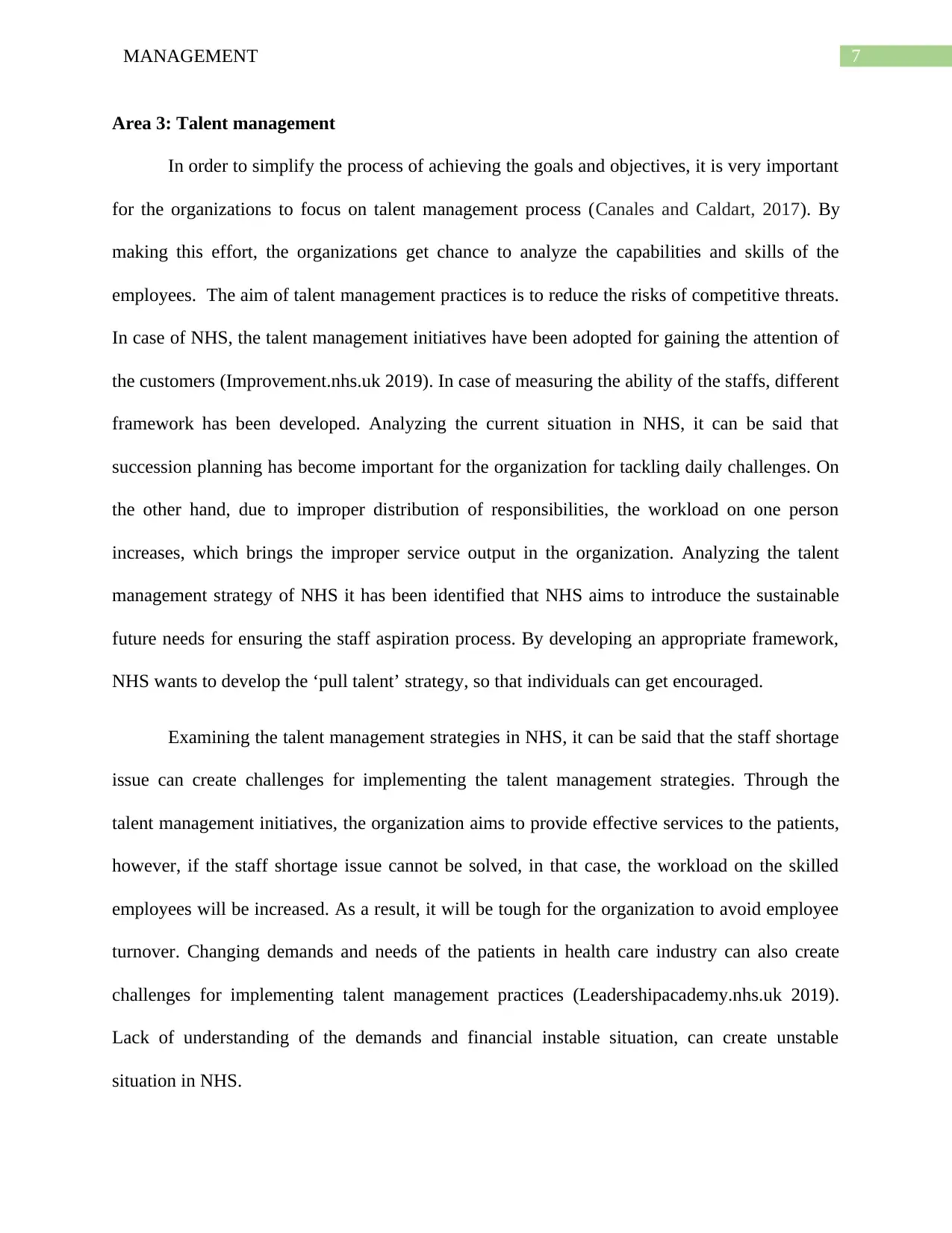
7MANAGEMENT
Area 3: Talent management
In order to simplify the process of achieving the goals and objectives, it is very important
for the organizations to focus on talent management process (Canales and Caldart, 2017). By
making this effort, the organizations get chance to analyze the capabilities and skills of the
employees. The aim of talent management practices is to reduce the risks of competitive threats.
In case of NHS, the talent management initiatives have been adopted for gaining the attention of
the customers (Improvement.nhs.uk 2019). In case of measuring the ability of the staffs, different
framework has been developed. Analyzing the current situation in NHS, it can be said that
succession planning has become important for the organization for tackling daily challenges. On
the other hand, due to improper distribution of responsibilities, the workload on one person
increases, which brings the improper service output in the organization. Analyzing the talent
management strategy of NHS it has been identified that NHS aims to introduce the sustainable
future needs for ensuring the staff aspiration process. By developing an appropriate framework,
NHS wants to develop the ‘pull talent’ strategy, so that individuals can get encouraged.
Examining the talent management strategies in NHS, it can be said that the staff shortage
issue can create challenges for implementing the talent management strategies. Through the
talent management initiatives, the organization aims to provide effective services to the patients,
however, if the staff shortage issue cannot be solved, in that case, the workload on the skilled
employees will be increased. As a result, it will be tough for the organization to avoid employee
turnover. Changing demands and needs of the patients in health care industry can also create
challenges for implementing talent management practices (Leadershipacademy.nhs.uk 2019).
Lack of understanding of the demands and financial instable situation, can create unstable
situation in NHS.
Area 3: Talent management
In order to simplify the process of achieving the goals and objectives, it is very important
for the organizations to focus on talent management process (Canales and Caldart, 2017). By
making this effort, the organizations get chance to analyze the capabilities and skills of the
employees. The aim of talent management practices is to reduce the risks of competitive threats.
In case of NHS, the talent management initiatives have been adopted for gaining the attention of
the customers (Improvement.nhs.uk 2019). In case of measuring the ability of the staffs, different
framework has been developed. Analyzing the current situation in NHS, it can be said that
succession planning has become important for the organization for tackling daily challenges. On
the other hand, due to improper distribution of responsibilities, the workload on one person
increases, which brings the improper service output in the organization. Analyzing the talent
management strategy of NHS it has been identified that NHS aims to introduce the sustainable
future needs for ensuring the staff aspiration process. By developing an appropriate framework,
NHS wants to develop the ‘pull talent’ strategy, so that individuals can get encouraged.
Examining the talent management strategies in NHS, it can be said that the staff shortage
issue can create challenges for implementing the talent management strategies. Through the
talent management initiatives, the organization aims to provide effective services to the patients,
however, if the staff shortage issue cannot be solved, in that case, the workload on the skilled
employees will be increased. As a result, it will be tough for the organization to avoid employee
turnover. Changing demands and needs of the patients in health care industry can also create
challenges for implementing talent management practices (Leadershipacademy.nhs.uk 2019).
Lack of understanding of the demands and financial instable situation, can create unstable
situation in NHS.
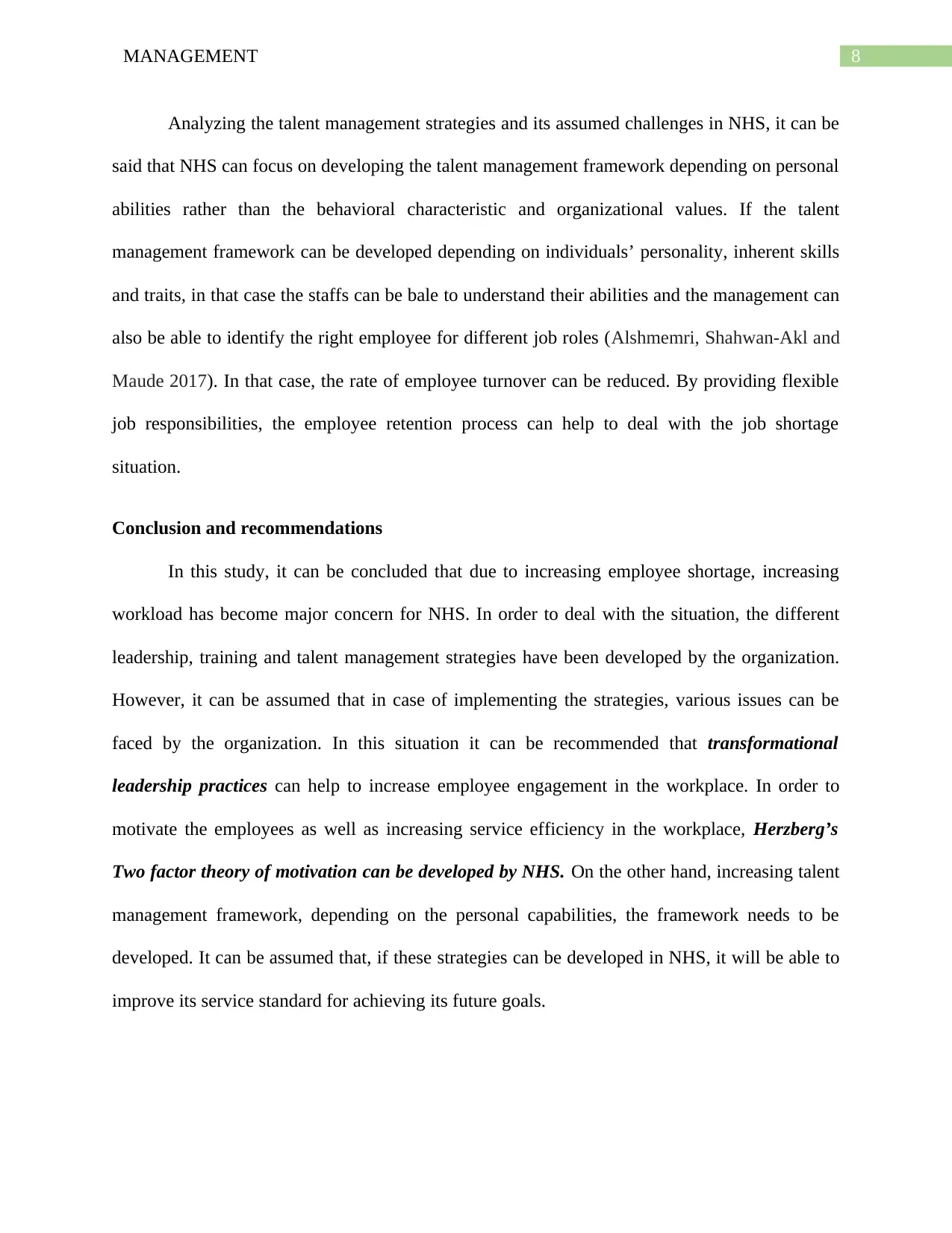
8MANAGEMENT
Analyzing the talent management strategies and its assumed challenges in NHS, it can be
said that NHS can focus on developing the talent management framework depending on personal
abilities rather than the behavioral characteristic and organizational values. If the talent
management framework can be developed depending on individuals’ personality, inherent skills
and traits, in that case the staffs can be bale to understand their abilities and the management can
also be able to identify the right employee for different job roles (Alshmemri, Shahwan-Akl and
Maude 2017). In that case, the rate of employee turnover can be reduced. By providing flexible
job responsibilities, the employee retention process can help to deal with the job shortage
situation.
Conclusion and recommendations
In this study, it can be concluded that due to increasing employee shortage, increasing
workload has become major concern for NHS. In order to deal with the situation, the different
leadership, training and talent management strategies have been developed by the organization.
However, it can be assumed that in case of implementing the strategies, various issues can be
faced by the organization. In this situation it can be recommended that transformational
leadership practices can help to increase employee engagement in the workplace. In order to
motivate the employees as well as increasing service efficiency in the workplace, Herzberg’s
Two factor theory of motivation can be developed by NHS. On the other hand, increasing talent
management framework, depending on the personal capabilities, the framework needs to be
developed. It can be assumed that, if these strategies can be developed in NHS, it will be able to
improve its service standard for achieving its future goals.
Analyzing the talent management strategies and its assumed challenges in NHS, it can be
said that NHS can focus on developing the talent management framework depending on personal
abilities rather than the behavioral characteristic and organizational values. If the talent
management framework can be developed depending on individuals’ personality, inherent skills
and traits, in that case the staffs can be bale to understand their abilities and the management can
also be able to identify the right employee for different job roles (Alshmemri, Shahwan-Akl and
Maude 2017). In that case, the rate of employee turnover can be reduced. By providing flexible
job responsibilities, the employee retention process can help to deal with the job shortage
situation.
Conclusion and recommendations
In this study, it can be concluded that due to increasing employee shortage, increasing
workload has become major concern for NHS. In order to deal with the situation, the different
leadership, training and talent management strategies have been developed by the organization.
However, it can be assumed that in case of implementing the strategies, various issues can be
faced by the organization. In this situation it can be recommended that transformational
leadership practices can help to increase employee engagement in the workplace. In order to
motivate the employees as well as increasing service efficiency in the workplace, Herzberg’s
Two factor theory of motivation can be developed by NHS. On the other hand, increasing talent
management framework, depending on the personal capabilities, the framework needs to be
developed. It can be assumed that, if these strategies can be developed in NHS, it will be able to
improve its service standard for achieving its future goals.
⊘ This is a preview!⊘
Do you want full access?
Subscribe today to unlock all pages.

Trusted by 1+ million students worldwide
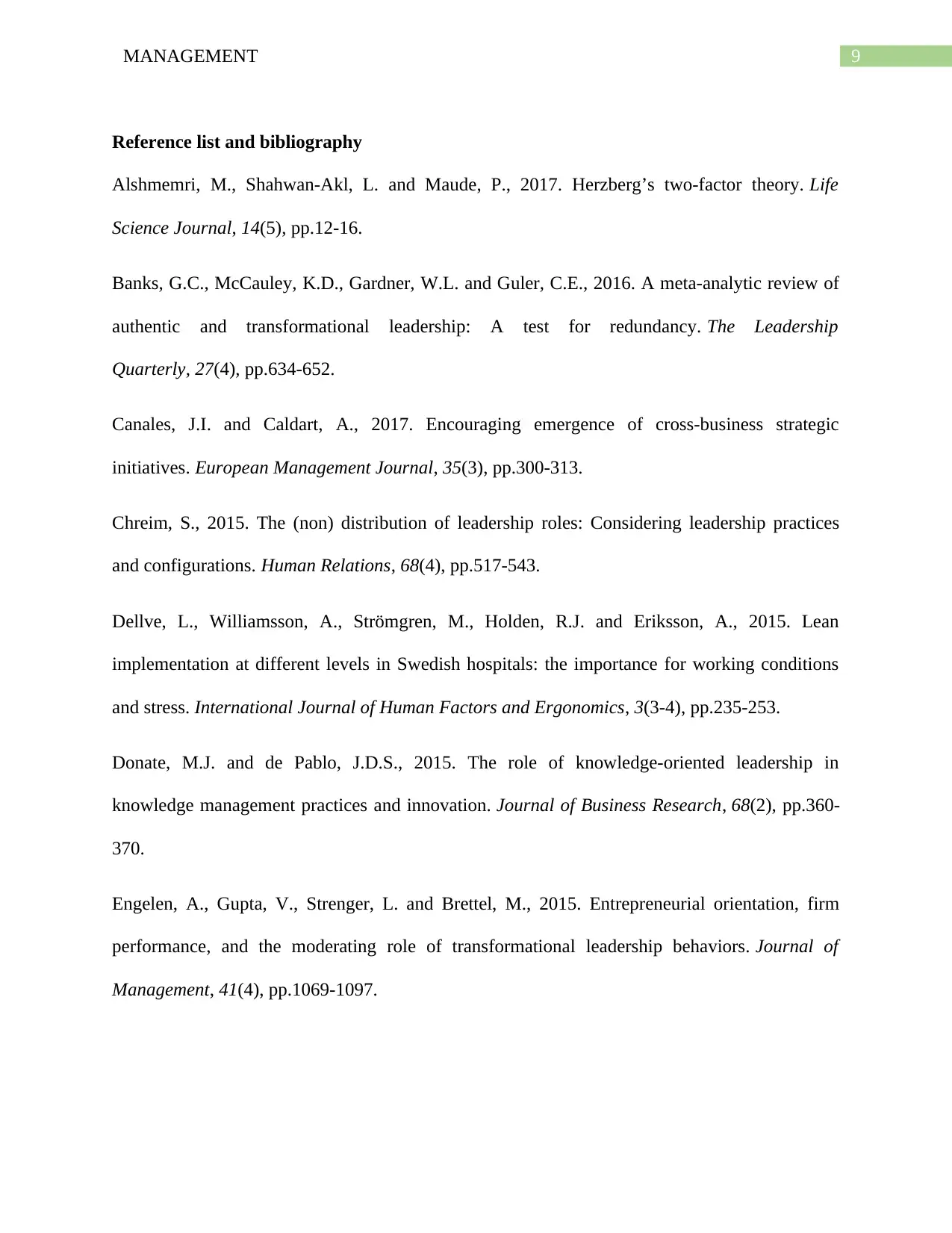
9MANAGEMENT
Reference list and bibliography
Alshmemri, M., Shahwan-Akl, L. and Maude, P., 2017. Herzberg’s two-factor theory. Life
Science Journal, 14(5), pp.12-16.
Banks, G.C., McCauley, K.D., Gardner, W.L. and Guler, C.E., 2016. A meta-analytic review of
authentic and transformational leadership: A test for redundancy. The Leadership
Quarterly, 27(4), pp.634-652.
Canales, J.I. and Caldart, A., 2017. Encouraging emergence of cross-business strategic
initiatives. European Management Journal, 35(3), pp.300-313.
Chreim, S., 2015. The (non) distribution of leadership roles: Considering leadership practices
and configurations. Human Relations, 68(4), pp.517-543.
Dellve, L., Williamsson, A., Strömgren, M., Holden, R.J. and Eriksson, A., 2015. Lean
implementation at different levels in Swedish hospitals: the importance for working conditions
and stress. International Journal of Human Factors and Ergonomics, 3(3-4), pp.235-253.
Donate, M.J. and de Pablo, J.D.S., 2015. The role of knowledge-oriented leadership in
knowledge management practices and innovation. Journal of Business Research, 68(2), pp.360-
370.
Engelen, A., Gupta, V., Strenger, L. and Brettel, M., 2015. Entrepreneurial orientation, firm
performance, and the moderating role of transformational leadership behaviors. Journal of
Management, 41(4), pp.1069-1097.
Reference list and bibliography
Alshmemri, M., Shahwan-Akl, L. and Maude, P., 2017. Herzberg’s two-factor theory. Life
Science Journal, 14(5), pp.12-16.
Banks, G.C., McCauley, K.D., Gardner, W.L. and Guler, C.E., 2016. A meta-analytic review of
authentic and transformational leadership: A test for redundancy. The Leadership
Quarterly, 27(4), pp.634-652.
Canales, J.I. and Caldart, A., 2017. Encouraging emergence of cross-business strategic
initiatives. European Management Journal, 35(3), pp.300-313.
Chreim, S., 2015. The (non) distribution of leadership roles: Considering leadership practices
and configurations. Human Relations, 68(4), pp.517-543.
Dellve, L., Williamsson, A., Strömgren, M., Holden, R.J. and Eriksson, A., 2015. Lean
implementation at different levels in Swedish hospitals: the importance for working conditions
and stress. International Journal of Human Factors and Ergonomics, 3(3-4), pp.235-253.
Donate, M.J. and de Pablo, J.D.S., 2015. The role of knowledge-oriented leadership in
knowledge management practices and innovation. Journal of Business Research, 68(2), pp.360-
370.
Engelen, A., Gupta, V., Strenger, L. and Brettel, M., 2015. Entrepreneurial orientation, firm
performance, and the moderating role of transformational leadership behaviors. Journal of
Management, 41(4), pp.1069-1097.
Paraphrase This Document
Need a fresh take? Get an instant paraphrase of this document with our AI Paraphraser
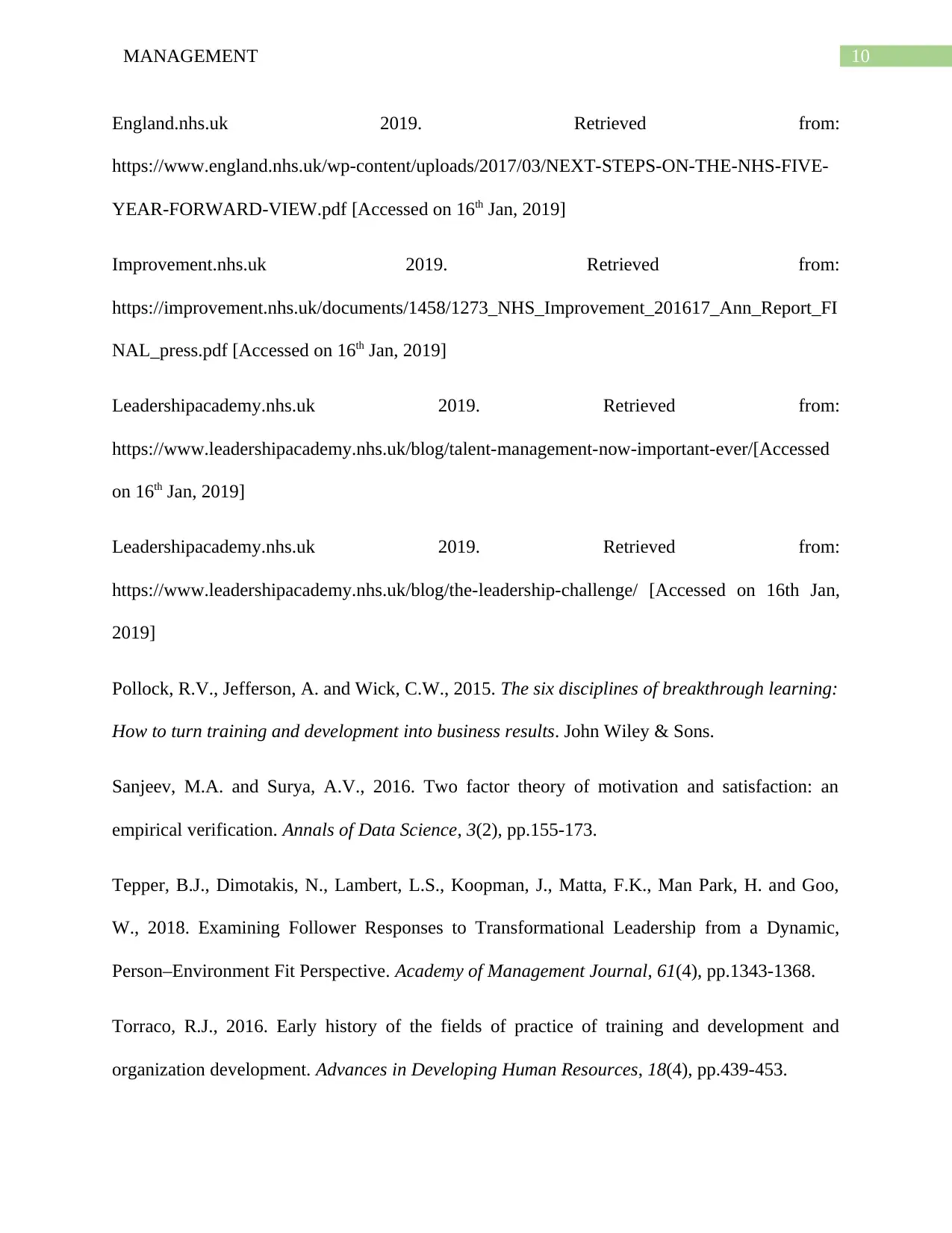
10MANAGEMENT
England.nhs.uk 2019. Retrieved from:
https://www.england.nhs.uk/wp-content/uploads/2017/03/NEXT-STEPS-ON-THE-NHS-FIVE-
YEAR-FORWARD-VIEW.pdf [Accessed on 16th Jan, 2019]
Improvement.nhs.uk 2019. Retrieved from:
https://improvement.nhs.uk/documents/1458/1273_NHS_Improvement_201617_Ann_Report_FI
NAL_press.pdf [Accessed on 16th Jan, 2019]
Leadershipacademy.nhs.uk 2019. Retrieved from:
https://www.leadershipacademy.nhs.uk/blog/talent-management-now-important-ever/[Accessed
on 16th Jan, 2019]
Leadershipacademy.nhs.uk 2019. Retrieved from:
https://www.leadershipacademy.nhs.uk/blog/the-leadership-challenge/ [Accessed on 16th Jan,
2019]
Pollock, R.V., Jefferson, A. and Wick, C.W., 2015. The six disciplines of breakthrough learning:
How to turn training and development into business results. John Wiley & Sons.
Sanjeev, M.A. and Surya, A.V., 2016. Two factor theory of motivation and satisfaction: an
empirical verification. Annals of Data Science, 3(2), pp.155-173.
Tepper, B.J., Dimotakis, N., Lambert, L.S., Koopman, J., Matta, F.K., Man Park, H. and Goo,
W., 2018. Examining Follower Responses to Transformational Leadership from a Dynamic,
Person–Environment Fit Perspective. Academy of Management Journal, 61(4), pp.1343-1368.
Torraco, R.J., 2016. Early history of the fields of practice of training and development and
organization development. Advances in Developing Human Resources, 18(4), pp.439-453.
England.nhs.uk 2019. Retrieved from:
https://www.england.nhs.uk/wp-content/uploads/2017/03/NEXT-STEPS-ON-THE-NHS-FIVE-
YEAR-FORWARD-VIEW.pdf [Accessed on 16th Jan, 2019]
Improvement.nhs.uk 2019. Retrieved from:
https://improvement.nhs.uk/documents/1458/1273_NHS_Improvement_201617_Ann_Report_FI
NAL_press.pdf [Accessed on 16th Jan, 2019]
Leadershipacademy.nhs.uk 2019. Retrieved from:
https://www.leadershipacademy.nhs.uk/blog/talent-management-now-important-ever/[Accessed
on 16th Jan, 2019]
Leadershipacademy.nhs.uk 2019. Retrieved from:
https://www.leadershipacademy.nhs.uk/blog/the-leadership-challenge/ [Accessed on 16th Jan,
2019]
Pollock, R.V., Jefferson, A. and Wick, C.W., 2015. The six disciplines of breakthrough learning:
How to turn training and development into business results. John Wiley & Sons.
Sanjeev, M.A. and Surya, A.V., 2016. Two factor theory of motivation and satisfaction: an
empirical verification. Annals of Data Science, 3(2), pp.155-173.
Tepper, B.J., Dimotakis, N., Lambert, L.S., Koopman, J., Matta, F.K., Man Park, H. and Goo,
W., 2018. Examining Follower Responses to Transformational Leadership from a Dynamic,
Person–Environment Fit Perspective. Academy of Management Journal, 61(4), pp.1343-1368.
Torraco, R.J., 2016. Early history of the fields of practice of training and development and
organization development. Advances in Developing Human Resources, 18(4), pp.439-453.

11MANAGEMENT
Walter, J., Lechner, C. and Kellermanns, F.W., 2016. Learning activities, exploration, and the
performance of strategic initiatives. Journal of Management, 42(3), pp.769-802.
Walter, J., Lechner, C. and Kellermanns, F.W., 2016. Learning activities, exploration, and the
performance of strategic initiatives. Journal of Management, 42(3), pp.769-802.
⊘ This is a preview!⊘
Do you want full access?
Subscribe today to unlock all pages.

Trusted by 1+ million students worldwide
1 out of 12
Related Documents
Your All-in-One AI-Powered Toolkit for Academic Success.
+13062052269
info@desklib.com
Available 24*7 on WhatsApp / Email
![[object Object]](/_next/static/media/star-bottom.7253800d.svg)
Unlock your academic potential
Copyright © 2020–2025 A2Z Services. All Rights Reserved. Developed and managed by ZUCOL.




